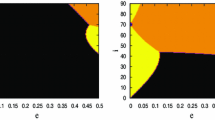Abstract
We study the dynamics of the space debris in regions corresponding to minor resonances; precisely, we consider the resonances 3:1, 3:2, 4:1, 4:3, 5:1, 5:2, 5:3, 5:4, where a \(j:\ell \) resonance (with j, \(\ell \in {\mathbb {Z}}\)) means that the periods of revolution of the debris and of rotation of the Earth are in the ratio \(j/\ell \). We consider a Hamiltonian function describing the effect of the geopotential and we use suitable finite expansions of the Hamiltonian for the description of the different resonances. In particular, we determine the leading terms which dominate in a specific orbital region, thus limiting our computation to very few harmonics. Taking advantage from the pendulum-like structure associated to each term of the expansion, we are able to determine the amplitude of the islands corresponding to the different harmonics. By means of simple mathematical formulae, we can predict the occurrence of splitting or overlapping of the resonant islands for different values of the parameters. We also find several cases which exhibit a transcritical bifurcation as the inclination is varied. These results, which are based on a careful mathematical analysis of the Hamiltonian expansion, are confirmed by a numerical study of the dynamical behavior obtained by computing the so-called fast Laypunov indicators. Since the Hamiltonian approach includes just the effect of the geopotential, we validate our results by performing a numerical integration in Cartesian variables of a more complete model including the gravitational attraction of Sun and Moon, as well as the solar radiation pressure.








Similar content being viewed by others
Notes
Since the coefficient \(J_2\) is much larger than any other zonal harmonic coefficient (see Table 1), the secular part is dominated essentially by the \(J_2\) harmonic terms. Without loss of generality, it is enough to discuss here just the influence of the \(J_2\) harmonic terms in order to catch the main effects of the secular part.
References
Bombardelli, C.: Analytical formulation of impulsive collision avoidance dynamics. Celest. Mech. Dyn. Astron. 118, 99–114 (2014)
Breiter, S., Wytrzyszczak, I., Melendo, B.: Long-term predictability of orbits around the geosynchronous altitude. Adv. Space Res. 35, 1313–1317 (2005)
Celletti, A.: Stability and Chaos in Celestial Mechanics. Springer-Verlag, Berlin; published in association with Praxis Publishing Ltd., Chichester (2010). ISBN:978-3-540-85145-5
Celletti, A., Galeş, C.: On the dynamics of space debris: 1:1 and 2:1 resonances. J. Nonlinear Sci. 24(6), 1231–1262 (2014)
Celletti, A., Galeş, C.: A study of the main resonances outside the geostationary ring. Adv. Space Res. 56(3), 388–405 (2015). doi:10.1016/j.asr.2015.02.012
Chao, C.C.: Applied Orbit Perturbation and Maintenance. Aerospace Press Series. AIAA, Reston (2005)
Chirikov, B.V.: Resonance processes in magnetic traps. At. Energ. 6 630 (1959), in Russian; Engl. Transl., J. Nucl. Energy Part C. Plasma Phys. 1, 253–260 (1960)
Chobotov, V.A.: Orbital Mechanics. American Institute of Aeronautics and Astronautics, Reston (1996)
Deleflie, F., Rossi, A., Portmann, C., Metris, G., Barlier, F.: Semi-analytical investigations of the long term evolution of the eccentricity of Galileo and GPS-like orbits. Adv. Space Res. 47, 811–821 (2011)
Deleflie, F., Alessi, E.M., Rosengren, A.J., Daquin, J., Valsecchi, G.B., Rossi, A., Vienne, A.: Choice of initial conditions for GNSS disposal orbits. Technical Note v. 7.0, ESA/ESOC Contract No. 4000107201/12/F/MOS (2015)
Earth Gravitational Model (2008). http://earth-info.nga.mil/GandG/wgs84/gravitymod/egm2008/
Ely, T.A., Howell, K.C.: Dynamics of artificial satellite orbits with tesseral resonances including the effects of luni-solar perturbations. Dyn. Stab. Syst. 12(4), 243–269 (1997)
Froeschlé, C., Lega, E., Gonczi, R.: Fast Lyapunov indicators. Application to asteroidal motion. Celest. Mech. Dyn. Astron. 67, 41–62 (1997)
Früh, C., Kelecy, T.M., Jah, M.K.: Coupled orbit-attitude dynamics of high area-to-mass ratio (HAMR) objects: influence of solar radiation pressure, earths shadow and the visibility in light curves. Celest. Mech. Dyn. Astron. 117, 385–404 (2013)
Galeş, C.: A cartographic study of the phase space of the restricted three body problem. Application to the Sun–Jupiter–Asteroid system. Commun. Nonlinear Sci. Numer. Simul. 17, 4721–4730 (2012)
Hubaux, Ch., Lemaître, A.: The impact of earths shadow on the long-term evolution of space debris. Celest. Mech. Dyn. Astron. 116, 79–95 (2013)
Kaula, W.M.: Theory of Satellite Geodesy. Blaisdell, Waltham (1966)
Klinkrad, H.: Space Debris: Models and Risk Analysis. Springer, Berlin (2006)
Lemaître, A., Delsate, N., Valk, S.: A web of secondary resonances for large \(A/m\) geostationary debris. Celest. Mech. Dyn. Astron. 104, 383–402 (2009)
Montenbruck, O., Gill, E.: Satellite Orbits. Springer, Berlin (2000)
Rossi, A.: Resonant dynamics of medium earth orbits: space debris issues. Celest. Mech. Dyn. Astron. 100, 267–286 (2008)
Sampaio, J.C., Neto, A.G.S., Fernandes, S.S., Vilhena de Moraes, R., Terra, M.O.: Artificial satellites orbits in 2:1 resonance: GPS constellation. Acta Astronaut. 81, 623–634 (2012)
Valk, S., Delsate, N., Lemaître, A., Carletti, T.: Global dynamics of high area-to-mass ratios geosynchronous space debris by means of the MEGNO indicator. Adv. Space Res. 43, 1509–1526 (2009a)
Valk, S., Lemaître, A.: Analytical and semi-analytical investigations of geosynchronous space debris with high area-to-mass ratios. Adv. Space Res. 41, 1077–1090 (2008)
Valk, S., Lemaître, A., Deleflie, F.: Semi-analytical theory of mean orbital motion for geosynchronous space debris under gravitational influence. Adv. Space Res. 43, 1070–1082 (2009b)
Acknowledgments
A.C. was partially supported by the European Grant MC-ITN Stardust, PRIN-MIUR 2010JJ4KPA_009 and GNFM/INdAM. C.G. was partially supported by GNFM/INDAM and the Romanian National Authority for Scientific Research (CNCS-257 UEFISCDI), Project No. PN-II-RU-TE-2014-4-0320.
Author information
Authors and Affiliations
Corresponding author
Electronic supplementary material
Below is the link to the electronic supplementary material.
Rights and permissions
About this article
Cite this article
Celletti, A., Galeş, C. Dynamical investigation of minor resonances for space debris. Celest Mech Dyn Astr 123, 203–222 (2015). https://doi.org/10.1007/s10569-015-9636-1
Received:
Revised:
Accepted:
Published:
Issue Date:
DOI: https://doi.org/10.1007/s10569-015-9636-1




